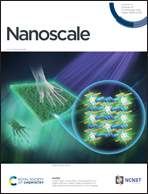Sequence-dependent twist-bend coupling in DNA minicircles†
Abstract
Looping of double-stranded DNA molecules with 100–200 base pairs into minicircles, catenanes, and rotaxanes has been suggested as a potential tool for DNA nanotechnologies. However, sharp DNA bending into a minicircle with a diameter of several to ten nanometers occurs with alterations in the DNA helical structure and may lead to defective kink formation that hampers the use of DNA minicircles, catenanes, and rotaxanes in nanoscale DNA applications. Here, we investigated local variations of a helical twist in sharply bent DNA using microsecond-long all-atom molecular dynamics simulations of six different DNA minicircles, focusing on the sequence dependence of the coupling between DNA bending and its helical twist. Twist angles between consecutive base pairs were analyzed at different locations relative to the direction of DNA bending and, among 10 unique dinucleotide steps, we identified four dinucleotide steps with strong twist-bend coupling, the pyrimidine–purine dinucleotide steps of TA/TA, CG/CG, and CA/TG and the purine–purine dinucleotide step of GA/TC. This work suggests the sequence-dependent structural responses of DNA to strong mechanical deformation, providing new molecular-level insights into the structure and stability of sharply bent DNA minicircles for nanoscale applications.



 Please wait while we load your content...
Please wait while we load your content...